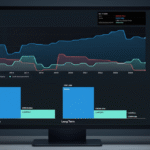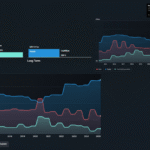The stock market delivered a mixed performance this week, with major indexes climbing on Friday but still finishing in negative territory following the release of critical inflation data that continues to shape Federal Reserve policy expectations.
Friday’s Recovery Rally
Major U.S. stock indexes staged a notable recovery on Friday, breaking a three-day losing streak. The Dow Jones Industrial Average led the charge, advancing 299.97 points or 0.65% to close at 46,247.29. The S&P 500 followed suit with a 0.59% gain, settling at 6,643.70, while the Nasdaq Composite rose 0.44% to finish at 22,484.07.
Despite Friday’s positive momentum, the rally wasn’t enough to offset earlier weekly losses. The Nasdaq Composite and S&P 500 both declined 0.7% and 0.3% respectively for the week, marking their first losing week in four. The Dow posted a more modest weekly decline of 0.2%.
Inflation Data Meets Expectations
The market’s performance was heavily influenced by August’s personal consumption expenditures (PCE) price index, the Federal Reserve’s preferred inflation gauge. Core inflation, which excludes volatile food and energy costs, registered a 2.9% seasonally adjusted annual rate—precisely in line with economist expectations surveyed by Dow Jones.
The broader all-items index showed an annual rate of 2.7% alongside a monthly gain of 0.3%, both meeting forecasts. This alignment with expectations provided some relief to investors who have been closely monitoring inflation trends for clues about future Federal Reserve policy.
Fed Rate Cut Expectations Remain Intact
The inflation data reinforced current market expectations regarding Federal Reserve policy. According to the CME FedWatch tool, markets continue to price in two quarter-point rate cuts at the Fed’s upcoming meetings, which aligns with the central bank’s own projections.
“Following a three-day pullback in the broader market, this is good enough to pull buyers off the sidelines,” commented David Russell, global head of market strategy at TradeStation. “Yesterday’s claims and GDP revision undermined the dovish narrative, but today’s PCE calms some of those worries. No news is good news.”
Economic Strength Creates Policy Uncertainty
The week brought a complex mix of economic indicators that created some uncertainty about the Fed’s future actions. Thursday’s solid jobs data and a strong upward revision in second-quarter gross domestic product to 3.8% initially dampened bullish sentiment. Investors expressed concern that fewer jobless claims could indicate a resilient economy, potentially giving the Federal Reserve less reason to implement aggressive rate cuts.
Consumer sentiment data from the University of Michigan for September also came in practically in line with expectations, with the reading only slightly lower than anticipated. Notably, sentiment remained particularly steady among those with larger stock holdings, suggesting confidence among equity investors persists.
AI Sector Faces Headwinds
While broader markets showed resilience, the artificial intelligence sector continued to face pressure. Software giant Oracle emerged as a notable laggard, falling more than 8% for the week amid ongoing questions about the sustainability and strength of the AI investment theme. Other AI-focused stocks similarly struggled, contributing to the market’s overall weekly decline.
Looking Ahead
The week’s trading action highlighted the market’s sensitivity to economic data and its implications for Federal Reserve policy. While Friday’s recovery demonstrated investors’ willingness to buy on dips, the overall weekly performance suggests caution remains as market participants navigate the complex interplay between economic strength, inflation trends, and monetary policy expectations.
The coming weeks will likely see continued focus on economic indicators and Fed communications as investors seek clarity on the central bank’s policy trajectory in an environment of moderating but persistent inflation and signs of economic resilience.

















